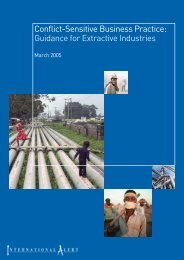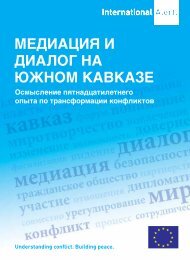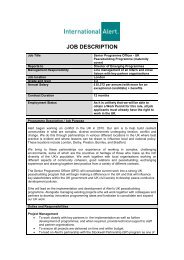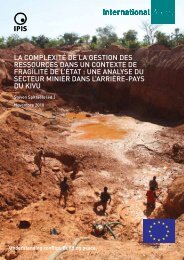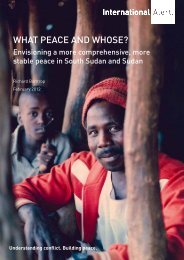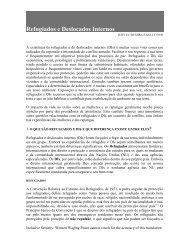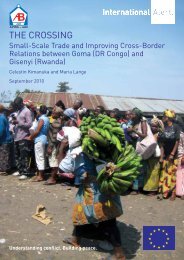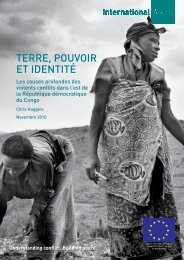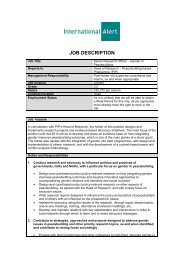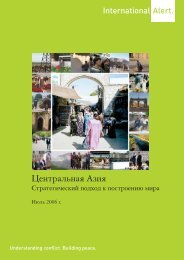Walking in the Dark: informal Cross-border trade ... - International Alert
Walking in the Dark: informal Cross-border trade ... - International Alert
Walking in the Dark: informal Cross-border trade ... - International Alert
You also want an ePaper? Increase the reach of your titles
YUMPU automatically turns print PDFs into web optimized ePapers that Google loves.
<strong>Walk<strong>in</strong>g</strong> <strong>in</strong> <strong>the</strong> <strong>Dark</strong>: Informal <strong>Cross</strong>-<strong>border</strong> Trade <strong>in</strong> <strong>the</strong> Great Lakes Region<br />
7<br />
1. Introduction<br />
1.1 Context, rationale and objectives<br />
Small cross-<strong>border</strong> <strong>trade</strong> plays an important role <strong>in</strong> <strong>the</strong> Great Lakes region, where goods are<br />
<strong>trade</strong>d between DRC, Rwanda, Uganda and Burundi. 6 This <strong>trade</strong> is mostly <strong>in</strong>formal <strong>in</strong>sofar as<br />
<strong>the</strong> <strong>trade</strong>rs are not registered and pay no <strong>in</strong>come taxes. However, <strong>the</strong>y do pay export or import<br />
taxes accord<strong>in</strong>gly and often pass through official <strong>border</strong> cross<strong>in</strong>gs with <strong>the</strong> appropriate travel<br />
documentation. They <strong>the</strong>reby contribute to <strong>the</strong> national economy, even though part of <strong>the</strong>ir<br />
operation is <strong>in</strong>formal. It is for this reason that we refer to “small” or “<strong>in</strong>formal” cross-<strong>border</strong><br />
<strong>trade</strong>.<br />
<strong>Cross</strong>-<strong>border</strong> <strong>trade</strong> is crucial for <strong>the</strong> supply of products to countries which do not have an adequate<br />
provision of goods for <strong>in</strong>dividual consumption, such as certa<strong>in</strong> foodstuffs. The importance of <strong>the</strong><br />
role played by cross-<strong>border</strong> <strong>trade</strong> is made clear <strong>in</strong> Table 1, which displays <strong>the</strong> export and import<br />
values of cross-<strong>border</strong> <strong>trade</strong> recorded <strong>in</strong> <strong>the</strong> Great Lakes region <strong>in</strong> 2009.<br />
Table 1: <strong>Cross</strong>-<strong>border</strong> <strong>trade</strong> <strong>in</strong> <strong>the</strong> Great Lakes region (2009, $000) 7<br />
Importer<br />
Burundi DRC Rwanda Uganda<br />
Burundi 7037 3291 426<br />
Exporter<br />
DRC 652 5975 4346<br />
Rwanda 1738 11392 3071<br />
Uganda 28515 78307 141853<br />
World 337649 1109830 4246228<br />
Much of this cross-<strong>border</strong> <strong>trade</strong> is not carried out by large-scale <strong>trade</strong>rs, but <strong>in</strong>stead by small<br />
<strong>trade</strong>rs who cross <strong>the</strong> <strong>border</strong> regularly. In <strong>the</strong> context of this report, small cross-<strong>border</strong> <strong>trade</strong><br />
is def<strong>in</strong>ed as follows: any revenue-generat<strong>in</strong>g cross-<strong>border</strong> commercial activity with a daily<br />
transaction value of less than 100 US dollars (USD) per <strong>trade</strong>r.<br />
This small <strong>trade</strong> is not only important for <strong>the</strong> supply of goods to <strong>the</strong> different regions concerned<br />
(this extends far beyond <strong>the</strong> specific <strong>border</strong> areas 8 ): it also provides a significant means of<br />
subsistence for small <strong>trade</strong>rs <strong>the</strong>mselves. It is <strong>the</strong>refore a key survival mechanism <strong>in</strong> <strong>the</strong> absence of<br />
economic alternatives. The lack of diverse livelihoods has resulted from <strong>the</strong> many cycles of violent<br />
conflict which have affected <strong>the</strong> region (and cont<strong>in</strong>ue to affect eastern DRC), and can also be<br />
l<strong>in</strong>ked to reforms that have deprived a segment of <strong>the</strong> population of <strong>the</strong>ir means of subsistence. As<br />
we will see, <strong>the</strong> revenue <strong>in</strong> most of <strong>the</strong> households concerned depends on this <strong>trade</strong>, which allows<br />
6 There is also significant <strong>trade</strong> between Tanzania and DRC (especially via Kigoma and Uvira); however, this is not dealt with <strong>in</strong> our study.<br />
7 World Bank (2011). ‘Facilitat<strong>in</strong>g cross-<strong>border</strong> <strong>trade</strong> between <strong>the</strong> DRC and Neighbors <strong>in</strong> <strong>the</strong> Great Lakes Region of Africa: Improv<strong>in</strong>g<br />
Conditions for Poor Traders’, Report No: 62992- AFR. Wash<strong>in</strong>gton.<br />
8 K. Titeca (2009). ‘The chang<strong>in</strong>g cross-<strong>border</strong> <strong>trade</strong> dynamics between north-western Uganda, north-eastern Congo and sou<strong>the</strong>rn Sudan’,<br />
Crisis States Work<strong>in</strong>g Paper 63 series 2. London School of Economics and Political Science, Crisis States Research Centre, London; K.<br />
Titeca and T. De Herdt (2010). ‘Regulation, cross-<strong>border</strong> <strong>trade</strong> and practical norms <strong>in</strong> West Nile, north-western Uganda’, Africa 80(4),<br />
pp.573-594.





